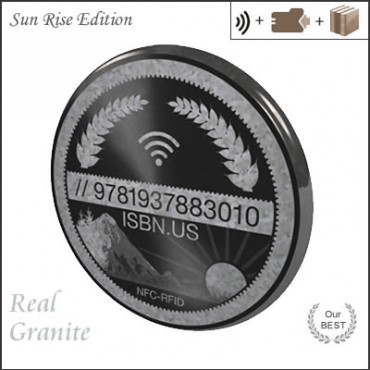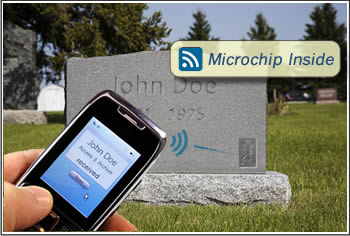RFID-NFC Headstone Product
 Almost three years ago we wrote about this technology - and it seemed somehow fitting to talk about it again over the Memorial Day weekend. The item is a NFC enabled marker that can go on a headstone or grave and contain content that can be retrieved with an NFC enabled cellphone. Another marker is engraved with a QR code.
Almost three years ago we wrote about this technology - and it seemed somehow fitting to talk about it again over the Memorial Day weekend. The item is a NFC enabled marker that can go on a headstone or grave and contain content that can be retrieved with an NFC enabled cellphone. Another marker is engraved with a QR code.
For those of us who are considering eschewing the traditional burial process (perhaps for ecological reasons) the company offers desktop granite mini-headstones, with the same embedded NFC-RFID technology. The desktop version uses roughly 1/100th of the amount of granite as a traditional marker.
I suppose that the use of any of these technologies implies some hope and faith that the specific technology will still be in existance in the future. Lately I have found that my Blue-ray DVD player won't handle my old CDs, and my laptop doesn't have a CD or DVD player or reader. I've long ago discarded my old Bernoulli discs, floppy disks, and other storage devices the names of which I don't even remember. The printed word has survived for thousands of years - maybe we should stick with what works?
(Maybe I shouldn't worry about it. Have a great Memorial day weekend!)

Our original article from 2010

Peel-and-stick RFID device adds wireless connection to new and existing headstones
Back in July, The Barcode News interviewed John Bottorff, General Manager at Objecs about the Company's exciting use of RFID technology in headstones. Earlier this week Objecs announced a new product. The 56mm diameter stone disk, item number D106, is the first RosettaStone product that can be applied directly by the consumer; no professional installation required.
The Personal RosettaStone is a small tablet mounted on a headstone that uses a microchip to archive a person's life history so that anyone with a smartphone can access it. The RosettaStone ties a person's life story to their memorial, monument or landmark using a data file. The data file is created by the stone's owner and is archived using Objecs proprietary data survival process called 'Push Distributed Archiving' (PDA), which has the ability to survive data files even beyond the existence of the company itself.
"The year 2010 is a historical time in our industry that marks the first use of true wireless technology with memorial markers," said John Bottorff, Objecs General Manager. "To put the concept in perspective, adding even a simple epitaph beyond the traditional name and date to a grave stone is easily north of $200 USD. In contrast, most RosettaStone products can preserve a short genealogical record of over 1000 words of text and a photo at the same price point."
The product's wireless capabilities are made possible by using both existing and emerging technologies. The Touch-to-Stone technology allows a passerby to access the stone's data by touching compatible cell phone to the stone. This wireless functionality is achieved by embedding a Near Field Communications-Radio Frequency Identification (NFC-RFID) microchip inside of the granite disk. NFC enabled handsets are not yet standard in the US, but users can access the same data file manually by using an existing Internet enabled mobile device.
The RosettaStone disk D106 will be available November 1, 2010 to Funeral Directors and industry professionals. Local distribution points include United States, Australia and South America.
You might also like:
The Point of Sale News, an online magazine dedicated to the retail industry.
Live Forever with RFID Technology

